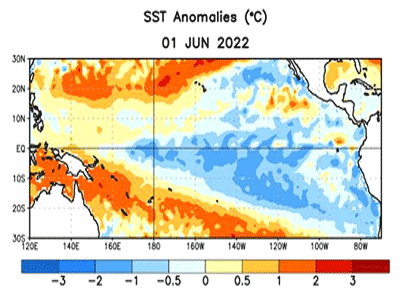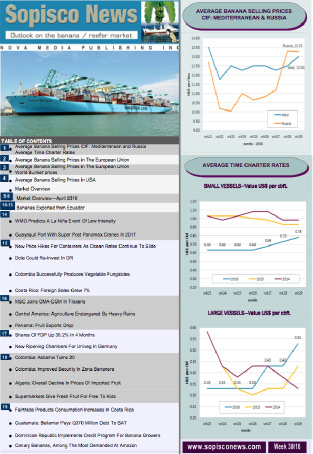La Niña is Expected to Continue Through the End of the Year
2022-06-17

According to NOAA, during May, below-average sea surface temperatures (SSTs) continued across most of the central and eastern equatorial Pacific Ocean (Fig. 1). However, negative SST anomalies weakened during the past month, as reflected by the Niño indices, ranging from -0.6ºC to -0.9ºC during the past week.
Subsurface temperature anomalies (averaged between 180°-100°W and 0-300m depth) also weakened, with values returning near zero. Below-average subsurface temperatures persisted near the surface to at least ~75m depth from the central to the eastern equatorial Pacific Ocean, with above-average temperatures continuing at depth (~100 to 200m) in the central and west Pacific Ocean. Low-level easterly wind anomalies prevailed in the east-central equatorial Pacific, while upper-level westerly wind anomalies continued over most equatorial Pacific. Convection was suppressed over the western and central Pacific and was weakly enhanced over parts of Indonesia. Overall, the coupled ocean-atmosphere system continues to reflect La Niña.
The most recent IRI/CPC plume average for the Niño-3.4 SST index forecasts La Niña to persist into the Northern Hemisphere winter 2022-23. This is now in greater agreement with the forecast consensus this month, which also predicts La Niña to continue into the winter. However, recent observed oceanic and atmospheric anomalies have weakened, which is anticipated to continue through the summer. Uncertainty remains over whether La Niña may transition to ENSO-neutral during the summer, with forecasters predicting a 52% chance of La Niña and a 46% chance of ENSO-neutral during July-September 2022. After this season, the forecast is for renewed cooling, with La Niña favoured during the fall and early winter. In summary, though La Niña is selected to continue through the end of the year, the odds for La Niña decrease into the Northern Hemisphere late summer (52% chance in July-September 2022) before slightly increasing through the Northern Hemisphere fall and early winter 2022 (58-59% chance).









